The Shanghai Riverside Promenade, affectionately known as Bingjiang Da Dao (滨江大道), spans 45 kilometers along both banks of the Huangpu River. Divided into five sections between the Yangpu Bridge and the Xupu Bridge, each segment bears the name of one of Shanghai’s districts.
- Yangpu (杨浦) Riverside (2.8km, belongs to Yangpu district)
- Hongkou (虹口) Riverside (2.5km, belongs to Hongkou district)
- Huangpu (黄浦) Riverside (8.3km, belongs to Huangpu district)
- Xuhui (徐汇) Riverside (8.4km, belongs to Xuhui district)
- Pudong (浦东) Riverside (23km, belongs to Pudong new district)
In this post, I detailed my stroll along the 2.5km-long Hongkou Riverside, which is situated in the Hongkou district.
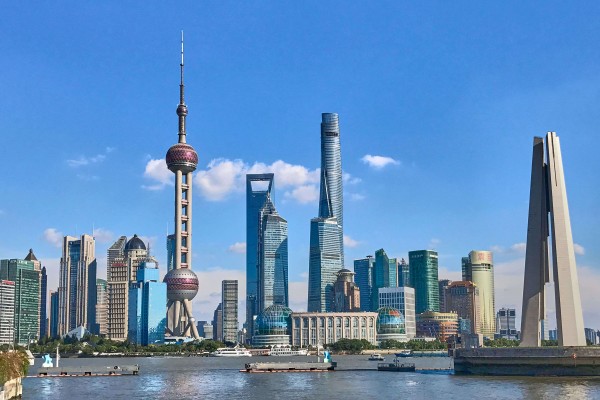
Shanghai Riverside Promenade: Exploring its Past and Present
Back when I resided in Shanghai years ago, memories flood back of the old living quarters, historical landmarks, and bustling factories that lined the Huangpu riversides. Over time, factories relocated or underwent transformations, and new bridges and tunnels emerged.
Then, a wave of renovations swept through the historical buildings, reshaping the skyline with modern skyscrapers. Today, the riverside has evolved into a vibrant recreational hub, offering a blend of history and leisure activities like jogging, walking, or cycling through lush greenery.
During my 2018 visit to Shanghai, I seized the opportunity to explore a new gem: the Shanghai Riverside Promenade, particularly the 2.5km stretch known as the Hongkou Riverside Promenade. Once an industrial area with aged ferry terminals, it lacked the appeal for leisurely strolls in my earlier years. But how has it transformed now?
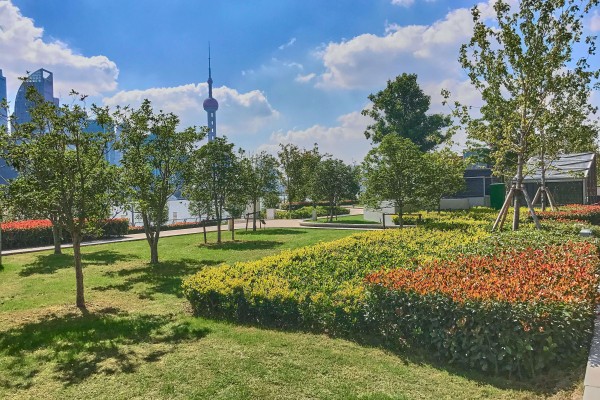
Shanghai Riverside Promenade, Hongkou district
The 2.5km stretch of the Shanghai Riverside Promenade, nestled within Hongkou district, encompasses the waterfront between Qinhuangdao Road (秦皇岛路) and Waibaidu Bridge (外白渡桥).
My journey began by boarding Metro Line 12 and exiting at Tilanqiao (提篮桥) station, near the site of East Asia’s first prison. Following Gongping Road (公平路), I made my way towards the riverside until reaching the Gongping Road Ferry Terminal. There, to the west, lay the Yacht Club, where several yachts were moored.
Continuing my stroll along the Huangpu River towards the west, I encountered numerous vantage points offering stunning views of the Oriental Pearl Tower and the Bund. The pathways and mini-parks along this section of the Shanghai Riverside Promenade are elevated. In contrast, buildings set further inland are situated at a lower ground level.
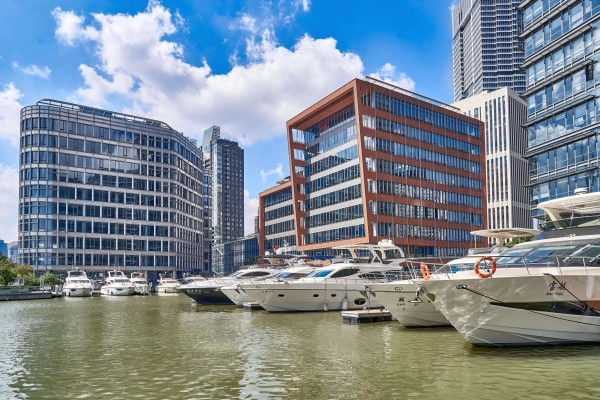
The main sites along the Hongkou section of Shanghai Riverside Promenade
- The Park and the walkways
- The Cruise City (SIPG)
- Auchon automatic supermarket
- Magic Jungle
- The Astor House Hotel
- Consulate General of Russia in Shanghai
- Broadway Mansions Hotel
- Waibaidu Bridge (外白渡桥)
The Park and the walkways
The Shanghai riverside promenade in Hongkou district features small gardens, flower beds, and artistic elements, creating a pleasant park landscape. Interconnected by winding paths, some paved with stone and others with expansive wooden decks, these pathways lead through shaded walkways amid bushes and trees, offering serene spots to enjoy the riverside view.
Designed for strolling, jogging, and cycling, the promenade features wide, spacious lanes. Despite being a weekday lunchtime, the promenade was remarkably uncrowded, a surprising oasis of leisure in the heart of bustling Shanghai. I relished the opportunity to capture countless photos without the usual throngs of tourists blocking the view.
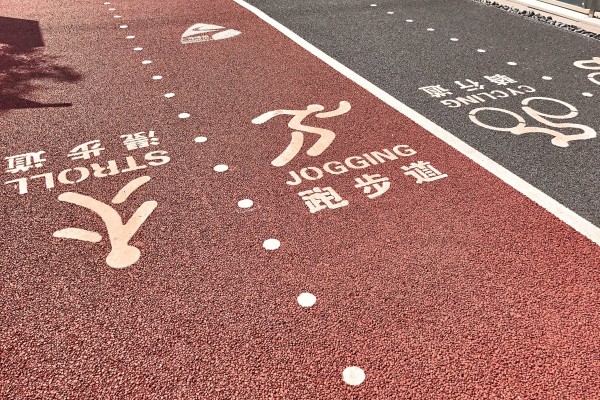
The Cruise City (SIPG)
Once, eight major docks lined the Huangpu River, including the renowned Gongping Road Dock, constructed by the British East India Company near East Daming Road (东大名路) in 1845. Today, the area is home to several landmark buildings, such as the towering White Magnolia Plaza (白玉兰广场), standing at 320 meters tall, the tallest structure in Puxi. Another notable site is the Shanghai International Port Group (SIPG) building, known as the cruise city.
Spanning 73,000 square meters, the cruise city features various attractions, including the Shanghai International Passenger Transportation Center, the Rainbow Bridge, the Shanghai Docks Heritage Museum, a sports park, a music plaza, and shopping malls. The transportation center exhibits a futuristic design, with sleek metal and glass façades, consistent with the stylish aesthetic of other landmark buildings.
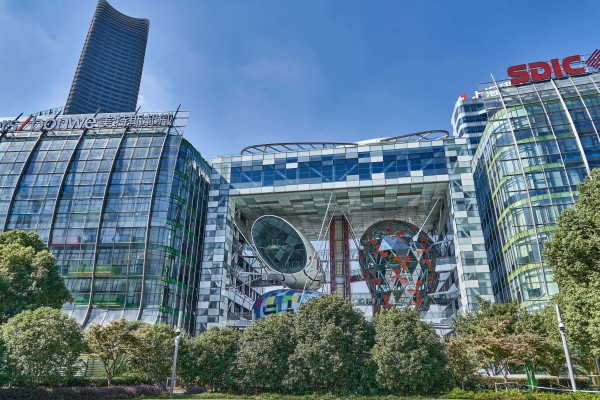
Auchon automatic supermarket
An Auchon automatic supermarket is now emerging, potentially replacing traditional kiosks found in tourist areas. Inside, no staff is present; customers must use an app for entry and scan products at the cash register. Payments are made using WeChat or Alipay. The supermarket offers snacks, drinks, and other daily essentials.
Reportedly, it caters to those aged 18 to 50, raising potential legal concerns regarding youth access. Additionally, elderly individuals may struggle with digital payments. What are your thoughts on this new shopping experience?
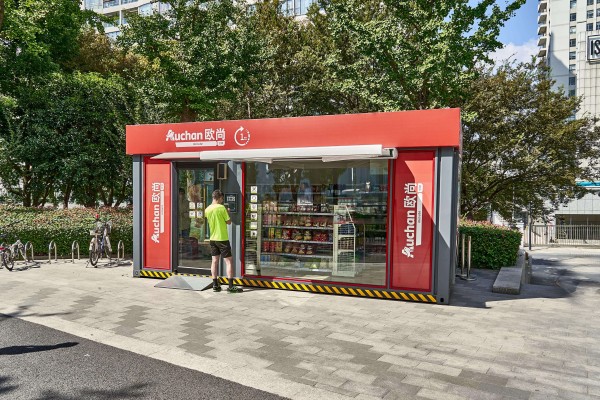
Magic Jungle
One of the newest features of the Shanghai riverside promenade is Magic Jungle (魔都矩阵), an outdoor entertainment complex.
Designed by Germans, this rope course offers 94 challenges suitable for all ages. As you climb, you can admire the waterfront view and experience the thrill of the giant swing, soaring over the water.
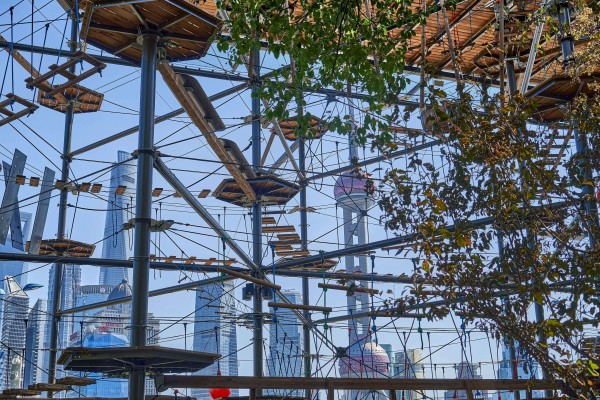
The Astor House Hotel
The hotel is a well-preserved historical gem along the Shanghai Riverside Promenade, situated at the junction of Suzhou Creek and the Huangpu River.
Originally established by Scottish merchant Peter Felix Richards in 1846, it was one of Shanghai’s first Western-style establishments. Initially named Richards’ Hotel and Restaurant (礼查饭店), it boasted Baroque architecture. Then, in 1859, it was rebranded as the Astor House Hotel. Over time, it gained fame for being the site of the city’s first electric lamp, telephone, and grand ballroom. Notably, in 1897, Empress Dowager Cixi (慈禧太后) celebrated her 60th birthday here with a lavish party.
On 27 May 1959, the Astor House Hotel was renamed the Pujiang Hotel (浦江饭店), marking a new chapter in its history. From 1920 to 1949, the Shanghai Stock Exchange operated from the premises until its relocation to Pudong. Subsequently, in 1990, the exchange briefly returned to the west wing’s ballroom before moving again. Despite these changes, the east wing continued as a state-run hotel. In December 2018, the China Securities Museum was inaugurated within the Astor House Hotel, displaying a collection of securities and bonds dating back to 1978.
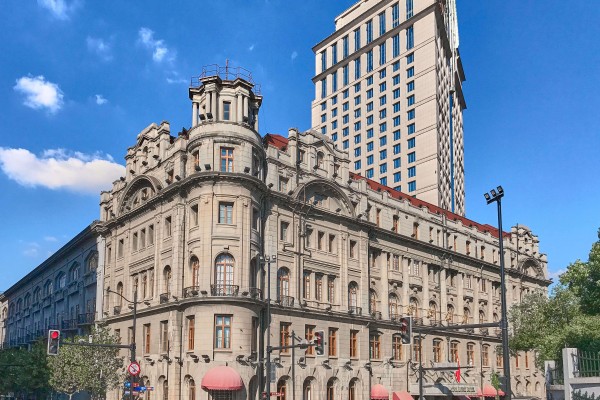
The building of Russian Consulate in Shanghai
Just across from the Astor House Hotel stands the Russian Consulate in Shanghai. In the late 19th century, the Russian government turned its investment attention to Manchuria, leading to a surge in trade between China and Russia. With the launch of regular ferry services between Vladivostok and Shanghai, Russian tea merchants flocked to the city. By 1905, several hundred Russian citizens called the Shanghai International Settlement home. To safeguard their interests, the Russian Consulate was established in 1896, occupying its current building since 1917.
Construction of the elegant consulate began in 1914 and concluded in 1916. However, during this period, the relationship between China and Russia fluctuated, leading to the consulate’s closure and reopening six times—an unusual occurrence in global history. For the best photo opportunity, head to the Waibaidu Bridge (外白渡桥).
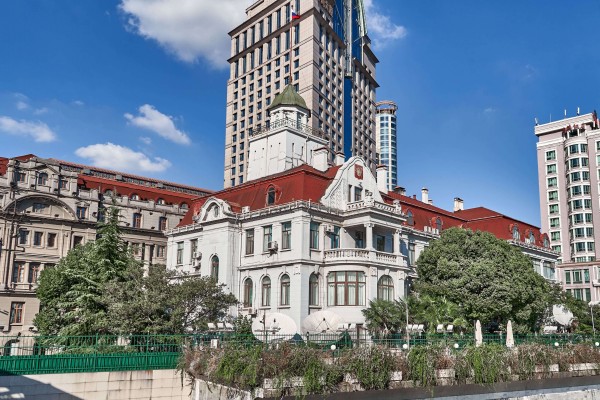
Broadway Mansions Hotel
Before reaching the Waibaidu Bridge (外白渡桥), I paused to admire the historic Broadway Mansions Hotel. Also known as the Shanghai Mansion, it’s an Art Deco gem designed by UK architect Mr. Bright Fraser. Originally an upscale residential hotel, its construction took four years.
During its build, the hotel was equipped with a telephone system, with its original number (46260) still in use today as the last five digits.
Broadway Mansions has four notable treasures: a piano imported from the UK in 1932, an Antique Snooker Table made in 1934, an OTIS Elevator—an antique hand-operated elevator, and a Gramophone from Victor, and a Gramophone from Victor, an American phonograph company established in 1917. Moreover, it offers the perfect vantage point to soak in the views of the Shanghai Riverside.
Waibaidu Bridge (外白渡桥)
The final historic gem along the Shanghai Riverside Promenade in Hongkou district is none other than the iconic Waibaidu Bridge. Spanning the Suzhou Creek, it marks the northern tip of the Bund and holds the distinction of being China’s first steel span bridge.
Just over a century and a half ago, there was no bridge across the Suzhou Creek; ferries were the sole means of passage. In 1856, a bold move by a British entrepreneur led to the construction of a vast wooden bridge, linking the British and American concessions. Dubbed Waibaidu, meaning “Outside of the Ferry Area” in the local parlance, it charged Chinese pedestrians a fee for crossing, sparking widespread protest. In response, the Garden Bridge, a free alternative, was erected nearby. Eventually, the original bridge was dismantled, making way for the 1908 steel structure that stands today. This upgrade also allowed streetcars to drive over the river.
Yet, Waibaidu Bridge offers more than mere passage. It serves as a vantage point for soaking in the charm of Suzhou Creek’s banks, with old-fashioned alleyways to the north and western architecture to the south. As night falls, the bridge illuminates, casting a gorgeous glow over the surroundings. Glancing eastwards, the skyline of the opposite bank, the Oriental Pearl Tower, Riverside Avenue, Jin Mao Tower (金贸大厦), and the World Financial Center are all clearly visible.

Travel Tips
Suggested tours
Where to stay
I’ve picked out three hotels that offer great value for money. While not budget options, they won’t break the bank either. Staying here means you’re conveniently located near the North Bund, and you can explore nearby attractions like Yu Garden, Lujiazhui Financial Centre, and the Oriental Pearl Tower without needing additional transportation. As evening falls and the city lights up, you can take a leisurely walk along the Bund, admiring the glittering skyscrapers on both sides of the river and immersing yourself in Shanghai’s lively nightlife.
How to get there
To reach the Bund, you have a couple of options. Firstly, you can hop on the Shanghai Hop-on Hop-off Bus Tour, specifically the Red Route, which includes a stop at the Bund. Once there, you can get off either at the waterfront or at Nanjing Road Pedestrian Street.
Next, you can take Metro Line 12 and exit at Tilanqiao Road (提篮桥). Alternatively, you can choose Metro Line 4 and get off at Yangshupu Road (杨树浦路). From either station, it’s just a short five to ten-minute walk to the Bund.
In general, depending on your location, there are numerous transportation options available to help you reach your destination in Shanghai.
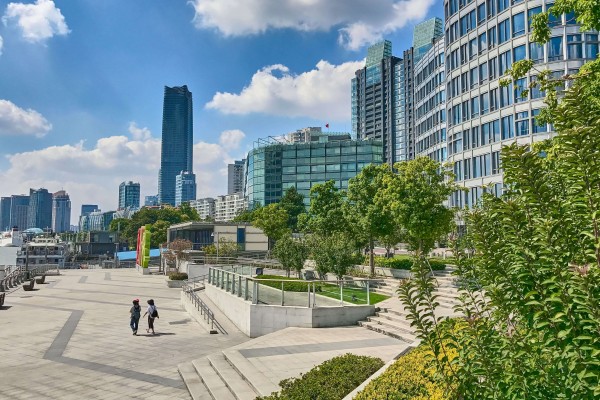
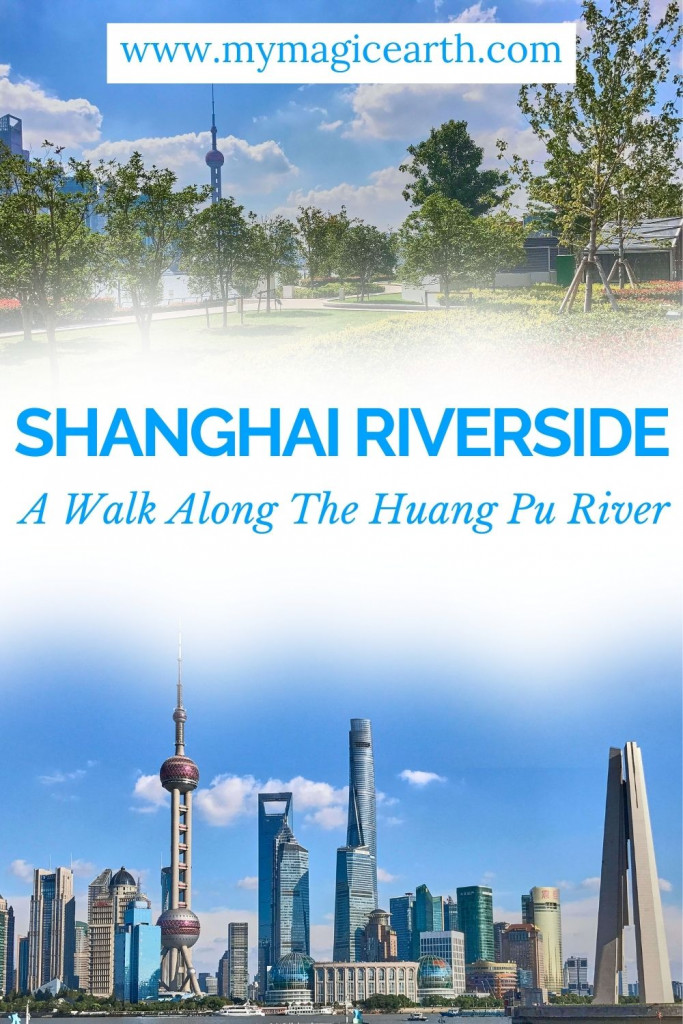
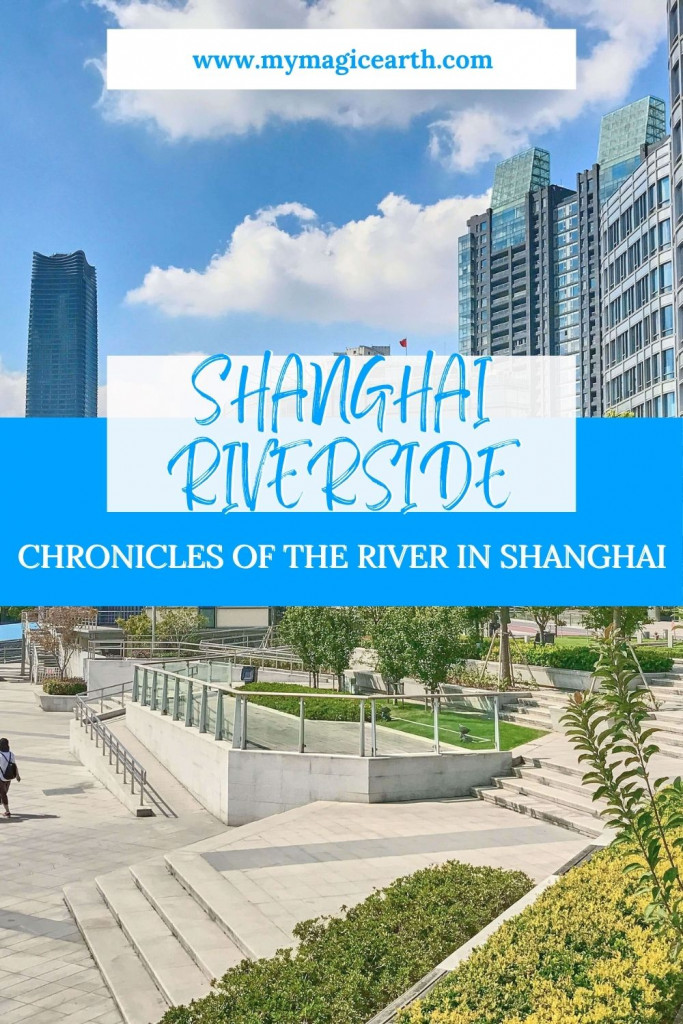
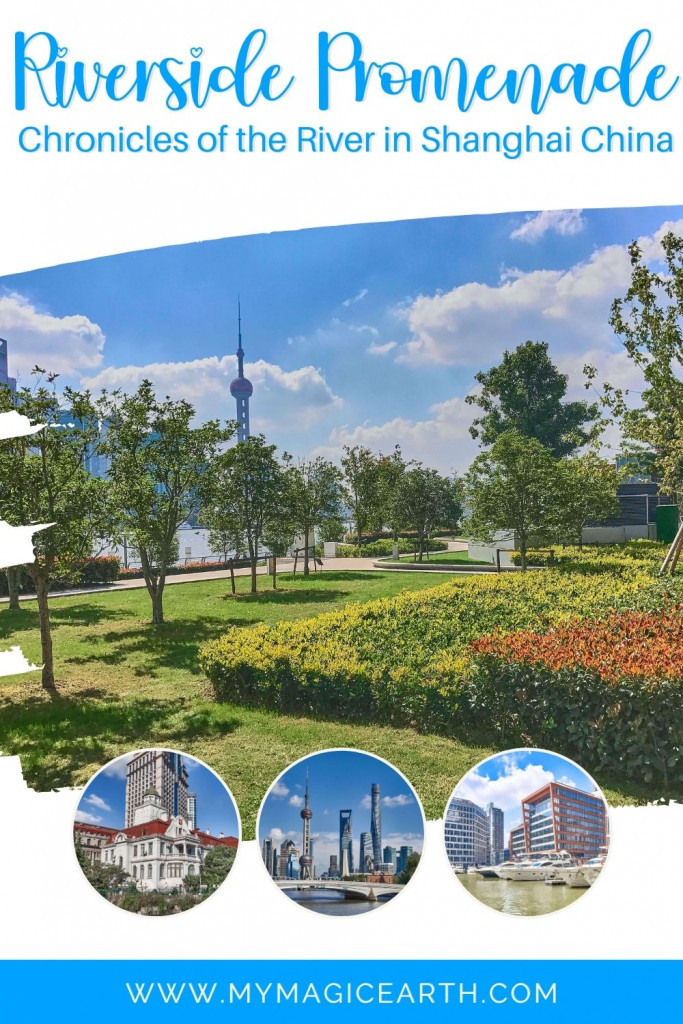

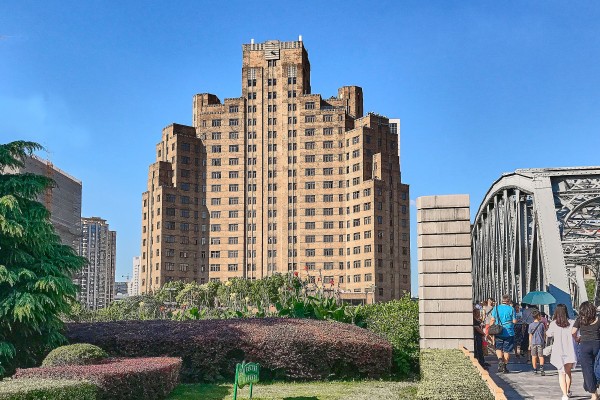
Wow, amazing photos! I hope to visit there one day! you should visit India also
I have China on my list to visit places and posts like these surely makes me want to tick that list even faster. There seems to be so much on offer and this is just one of them which adds the depth to a great booming desalination. It surely is unique with a 45km-long walkway along both sides of the Huangpu River and so many things to see and do as you go along it. Like the country advancing in leaps and bounds the example of the The Automatic Supermarket looks astonishing yet very practical sow would give that a shot if I was there. Thanks for sharing
Living in India, it’s so difficult for me to imagine a supermarket without staff. But this walkway sounds like a must see at sunrise and sunset. The view would be awesome I am sure. I really feel like walking in the park and seeing the sunlight flitter over the water. And see the Waibaidu Bridge. On my bucket list now.
The Shanghai promenade looks sleek and beautiful. The Magic jungle and the cruise city are my favorites in your guide. The park and the walkways look so lively! I’d say a must-visit when in shanghai.
This is a great part of Shanghai to explore. Unfortunately, when I was there The Astor House Hotel was being renovated so it was mostly covered in scaffolding. I’d love to go back one day and explore more of the area. I have pinned this for my next trip back to China.
What an extremely informative post. Shanghai is on 2020 travel list. AMD now I even have the list of hotels and how to get to Shanghai riverside.
What a great idea to take the Hop on Hop off Bus to start the walks around Shanghai. There is so much to do, I am not sure where I would start. The Automatic Supermarket looks like a fun thing to do. The Astor House Hotel looks a great place to visit – I love visiting historical hotels in my travels and finding out about their history. I love Shanghai and have visited a few times but there is always something new to see and do.
What an interesting read, I don’t know much about Shanghai so it was good for me to learn more. I was particularly interested in the cruise city as I recently took a cruise and this ship is now based out of Shanghai. I thought the automatic supermarket looked like a cool thing to try but I wonder if it’s easy for tourists to use?
Hi Laura,
When I was there I saw people used the WeChat or Chinese PayPal to entre the door. So for the tourists without such payment methods it is not possible to entre yet. That’s why some local elderly also have problems to handle digital payments. But as things change very quick in Shanghai, if I visit Shanghai next time, I would take a look and see if new payment methods are available or not. Nevertheless, it is interesting to see such automatic supermarket existing there.
Best regards,
Mijia
The Shanghai riverside promenade looks spectacular. Would love to visit it someday. The Park and the walkways seems a perfect place to spend a day. The river cruise on the Huangpu sounds exciting.
beautiful phtography and very informative article
Wow this looks and sounds absolutely magnificent! I would love to visit. Thank you for sharing this beautiful place with us!